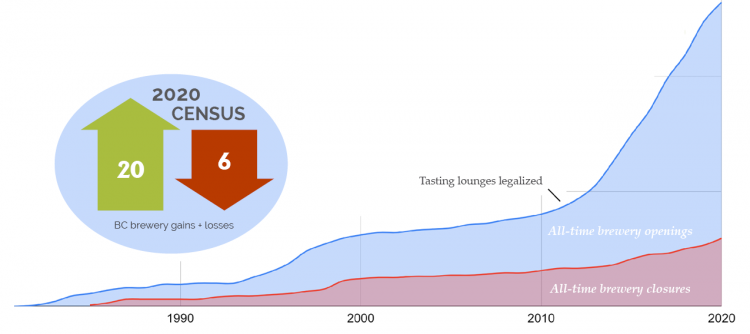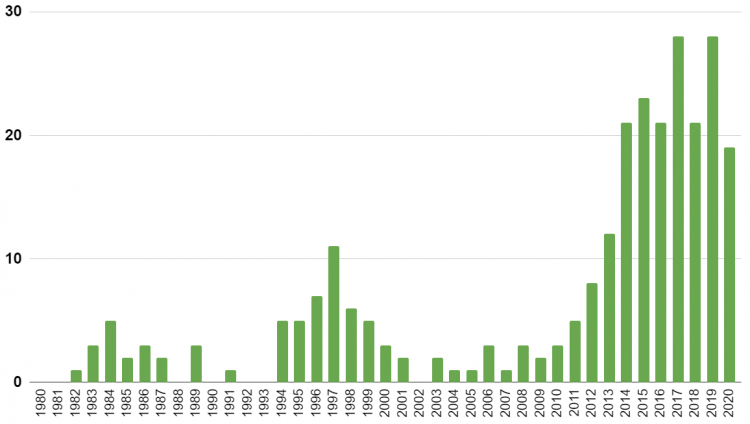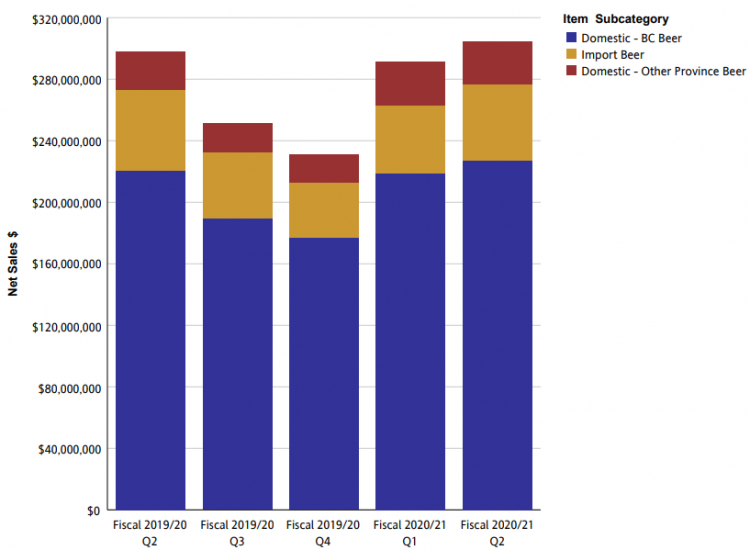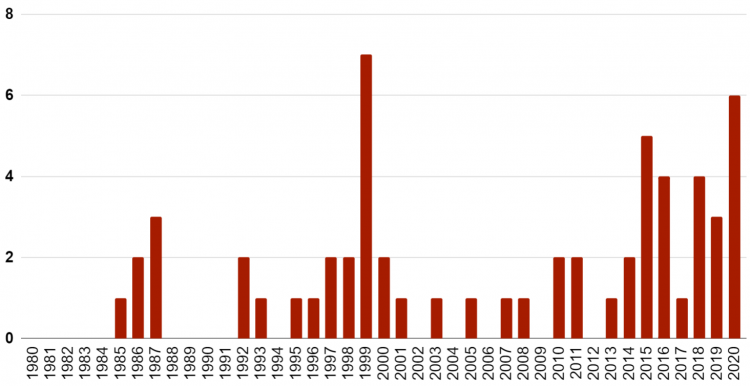
Did 2020 Impact BC Brewery Growth?
The question is out there. Did COVID kill craft beer’s momentum? Is this wave of the craft beer revolution over?
The returns are in. 2020 could have been a lot worse.
So far this year, twenty new breweries have opened in BC. Four of those are direct replacements for breweries that closed. The swaps include V2V Black Hops Brewing for Axe & Barrel; Welton Brewery for Boundary Brewing Company; and Settlement Brewing for Postmark. We’re also counting Postmark’s former corporate master, Craft Collective Beerworks, the former Factory Brewing who rebranded as TBA Beverages in this past spring when their business failed. That brewery was acquired by Mod Beverage in October (you may or may not consider them craft, but we’ll specify our criteria momentarily.)
Two others (Coal Harbour and Hearthstone) ceased brewing operations during 2020, but odds seem reasonable that those brewhouses will come alive again at some point. If they do, it will mean that no physical breweries were permanently lost during 2020.
The fact that four locations already gained new management underscores that there are still a number of businesspeople, presumably in full control of their faculties, who are willing to wade into the brewing industry even during a year like this. Even greater proof of the enduring attraction of brewery ownership lies in the sixteen other operations which have risen from the ground up and launched so far during 2020.
Naturally, we would have seen even more, had COVID not disrupted construction schedules and business plans. At the end of 2019, the What’s Brewing BC Craft Beer Map tracked as many as 27 BC breweries in some form of development. At the beginning of April, before the massive pivot from on-premises to at-home consumption created a lifeline for the industry, it looked to be a lost year for those brewery openings, and that notion lasted through summer.
However, thanks to a late surge, 2020 won’t go down as a year of stagnation after all. In a one-month period from the late October to late November, The Hopline announced six new breweries—a rate of more than one per week. Then, just before Christmas, Hopline editor Ed Kaye reinforced the theme while announcing a milestone. With the opening of La Cerveceria Astilleros in late December, BC avoided recording the first year since 2013 with fewer than 20 openings. As it stands, the twenty so far brings our calculation to 208 operating craft breweries in BC.

What is a “Craft Brewery”?
In Part I and Part II of a series called ‘Business of Beer’, this author put forward the assertion that any measurement or criterion used to separate “craft breweries” from “non-craft breweries” is pointless. I did however offer a definition of “craft brewing”, based around the admittedly-subjective notion of ethos—and despite the difficulties of truly knowing a brewery owner’s ethos, I’ve noticed that a few other writers have come to the same conclusion. We like to think that craft brewers are the good guys.
When constructing a historical database that encompasses the near-four-decade craft brewing renaissance, as used in the 30th Anniversary issue of What’s Brewing magazine this past summer, one needs a more inclusive approach. So the definition of “craft brewery” for today’s purpose is “Commercial operation employing its own physical microbrewing facility”.
The candidate doesn’t have to be completely independent; if it did, we couldn’t count Vancouver Island Brewing (owned by a large Ontario craft brewer). For purposes such as BC Craft Brewers Guild membership, it’s possible and patriotic to distinguish such Canadian ownership as better than that by a foreign multinational—and that’s how we think when we’re out buying beer. But for consistency across our historical measurement we include still-extant operations like Granville Island Brewing’s classic location, which was, and (on its own) still is, clearly a microbrewery. That means we must also include the likes of Stanley Park Brewpub.
You have every right to turn your nose up at these quaint megabrewery outposts—although I would then wager I could name a few of BC’s still-independent microbreweries that your nose has looked unkindly upon as well. Set that aside. Today, we are simply counting the micros, and our defining characteristic is ownership of a legitimate brewhouse. What we’re not counting are “virtual breweries”: contract brewers, white labels, shadow brands and the like. Also of course, not the macros.
A craft brewhouse can range in size from a tiny nano to something like Central City Brewing’s Bridgeview plant. Large as the latter is, it’s not macro scale. That (and date of founding) is how we distinguish between our “craft revolution” generation of players and those like Molson, with its massive Chilliwack plant—as well as Labatt’s Columbia Brewery in Creston, Sapporo/Sleeman’s Okanagan Spring plant in Vernon, and Pacific Western’s regional-level brewery in Prince George. A day will come when craft behemoths like Phillips Brewing & Malting Ltd. will overtake those like Pacific Western not only in terms of sales but in size of physical brewing operations…but we’re not there yet.
As noted in Part III of this series, it’s likely that these breweries won’t be called “craft” forever. That won’t necessarily be because they crossed some arbitrary, subjective threshold of size, quality or trendiness; it’s simply because the term “craft beer” will no longer be needed by (at least that segment of) the industry at some point. Clearly, a couple of generations from now, this term will have lost its purpose and people will associate the “craft wave” with a moment in time. (Apparently, we’re not at that stage yet though, as evidenced by the marketing of Central City’s Beer League “Craft-Brewed Lager”.)

What is a “Wave”, and is it over?
Which brings us to the definition of “wave”. Plainly, there has been more than one wave of interest during the craft beer renaissance…however, there was a time when this author struggled to pin down which wave we were currently in. Fortunately, the Birth Rate bar chart shows us exactly how many waves have taken place, because, as J. Random noted in last week’s feature, we can clearly see the existence of three distinct bumps, each bigger in size than the last.
Earlier this year, the question was whether the current wave would be completely lopped off, another casualty of 2020. Well, BC Liquor Distribution Branch sales during the Summer of COVID are in, and they provide an indication.

We see that the winner in terms of growth is the “Micro Brew” segment with a 3.8% increase—much smaller than years past, but a full point better than “Commercial” (the mega brewers) with their retail muscle and cheap appeal to stay-at-home volume buyers. The loser was “BC Regional Beer”. Without the benefit of little-guy chic, or macro beer’s economies of scale, this segment seems to be stuck in the middle and eaten away at both ends, as is typically the case in business.
Of course, we have extensive anecdotal evidence from the panel of brewers who participated in this issue’s Industry feature. It seems that, despite a drop from 28 new breweries last year to 20 this year, we’re still floating close to the top of the third wave. With the BC Craft Beer Map counting as many as 30 BC breweries in the pipeline, it should take some time to recede.

Will we see a “fourth wave”? For that, we need to remember that “wave” doesn’t just mean “a steady increase in breweries”. It begins with an unusual curve upwards, as seen in the mid-’80s, mid-’90s and the early 2010s. For a fourth wave to be possible, a period of fallow has to occur (which was the case after both the first and second waves).
At that point, it should be sufficiently far into the future that the massive exposure and goodwill “gourmet beer” has basked in is no longer top of mind for a new generation. Otherwise, such a wave will be qualitatively different, because the first three waves were all about one thing: discovery.
As for 2020, it seems likely that the days of growth acceleration are over, and a plateau phase is beginning. But that’s not the same as a tragic decline.
So, it seems that 2020 won’t be the all-time year of devastation some foresaw back in March and April. As of publication time, the year 1999 remains the bloodiest era in BC brewing with seven lost. Let’s hope we get through December with no further casualties so as to avoid tying that record. Small victories must be celebrated.
This Post Has 0 Comments